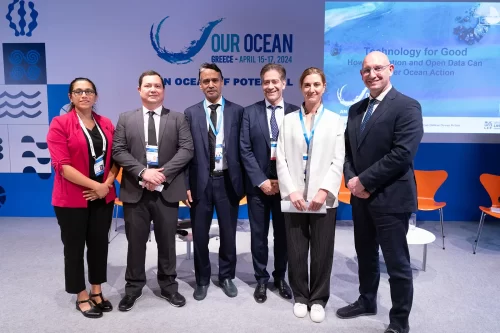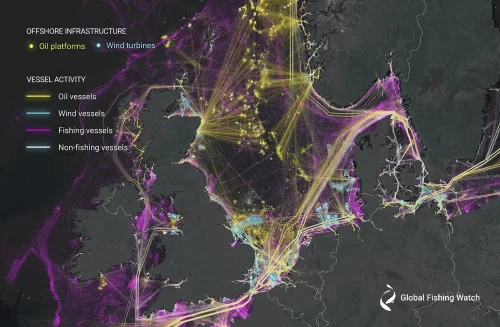Jakarta, Indonesia – The presence of foreign fishing vessels in Indonesian waters has declined significantly since a ban was enacted in November 2014 by the Minister of Maritime Affairs and Fisheries, Susi Pudjiastuti, according to new analysis by Global Fishing Watch (GFW).
By analysing data from the Automatic Identification System (AIS) (1), an open source vessel tracking system, GFW found that up to 6,800 hours of fishing activity by foreign fishing vessels were detected every month in Indonesia waters between 2012 and 2014. The monthly number dropped by over 90% in the months following this ban. This result is validated and supported by analysis of other vessel tracking data – VMS and VIIRS, that also show significant decline of foreign vessels activity in Indonesia after moratorium.
Minister Susi recently reported that about 10,000 foreign vessels have been turned away from Indonesian waters since the crackdown on illegal fishing began in 2015, and more than 500 foreign vessels have been seized and destroyed. Scientific research shows that the Minister’s tough stance on fighting illegal fishing has jump-started fisheries recovery in Indonesia’s waters.
“The ban on foreign vessels or foreign actors in capture fisheries that was implemented by Minister Susi has proven to be effective in increasing our fish stocks,” said Dr. Achmad Santosa, Illegal, Unreported and Unregulated (IUU) Fishing Task Force Coordinator (Satgas 115). “Not only have our fish stocks increased, but the access for our fishermen and national fishing industry has grown, while incursions by foreign vessels have been reduced.”
The analysis also shows the presence of foreign vessels in some areas at the edge of Indonesia’s Exclusive Economic Zone (EEZ), without notable declines since the ban. Heightened monitoring to detect violations in border areas is needed, where GFW analysis indicates refrigerated cargo vessels, known as reefers, are meeting with other boats to potentially engage in prohibited activity, such as transshipment.(2)
Earlier this month, GFW analysis contributed to locating Vietnamese vessels fishing illegally within Indonesian waters. A vessel named BV 8909 TS was later intercepted with 500 kg of fish caught in the waters of the North Natuna Sea, and was seized by Indonesian authorities.
“In the future, we need to strengthen the presence of Indonesian vessels in fisheries management areas that to date are rarely visited by our fleet. The facts show that the presence of Indonesian fishing vessels in a region reduces incursions by foreign fishing vessels,” added Dr. Santosa. “Our patrols in the northern Natuna area near our EEZ line, and the border area with Palau, Papua New Guinea and Timor must be strengthened.”
The analysis also shows that from 2012-2014, just over 90% of foreign fishing boats detected in Indonesian waters carried Chinese or Chinese Taipei flags and were 80-1500 gross tonnage (GT) in size.
The analysis follows a recent study that cross-referenced Indonesia’s Vessel Monitoring System (VMS) data – used to track their industrial fishing fleet, with Visible Infrared Imaging Radiometer Suite (VIIRS) satellite data, which picks up the presence of fishing vessels that use bright lights to attract catch or conduct operations at night. Matching of the two data sets in near real time could greatly help authorities identify dark vessels – boats that switch off tracking devices, likely to avoid detection.
“Indonesia’s lead in sharing its VMS data publicly has enabled us to support the government’s work to better understand some of their marine issues and control their fisheries,” said Ahmad Baihaki, Indonesia Program Manager, Global Fishing Watch. “We hope to see more analyses like this coming out of our collaboration with the Indonesian government, academics or anyone who has a stake in achieving a sustainable ocean.”
In 2017, Indonesia became the first nation to make its proprietary VMS tracking data available via GFW, instantly putting 5,000 smaller commercial fishing boats that don’t use AIS on the map. In Indonesia, registered industrial-scale fishing vessels in general do not use AIS as one of their navigation devices. Fishing vessels that operate in Indonesia with a minimum of 30 GT must install VMS for centralized monitoring purposes. (3)
GFW is an international non-profit organization dedicated to advancing the sustainability of marine resources through increased transparency. By utilizing the latest technology, the GFW platform allows everyone to view or download global fishing activity data in near real-time, for free. GFW was founded in 2015 through a collaboration between Oceana, SkyTruth and Google.
For further information, please contact:
Sarah Bladen, GFW Communications Director, sarah{@}globalfishingwatch.org/
Nabiha Shahab, GFW Indonesia communications consultant, nabiha{at}globalfishingwatch.org/
Editor’s note:
1) AIS stands for Automated Identification Systems. AIS is a navigation system used by large-sized vessels when sailing to avoid collisions with other ships. The use of AIS is regulated by the IMO (International Maritime Organization), a special body of the United Nations (United Nations) which is in charge of regulating sea transportation regulations.
Ships that use the AIS system transmit data containing the main information on their position, direction and speed. This information can be mutually accepted and known by other ships in the vicinity, so that each ship can sail safely and avoid collisions with other ships. Each AIS tool has an identification number called MMSI (Maritime Mobile Service Identity). Ideally this number is unique for each ship.
The AIS Protocol is open. Therefore, by AIS satellite providers, AIS data transmission from each vessel is captured, collected and used for commercial purposes. Global Fishing Watch, using AIS data, analyzes the movement of fishing vessels in particular and other types of vessels related to fishing activities in general, throughout the world, for the purpose of marine transparency for sustainable fisheries. Global Fishing Watch has AIS data from 2012 to the present from AIS data providers, mainly from Orbcomm and Spire. Based on this AIS data, an analysis of the existence of foreign vessels in Indonesian waters since 2012 was carried out.
Some obstacles, risks and challenges that may be encountered in using AIS data for this analysis are the finding of population samples with non-standard MMSI numbers (irregular MMSI), MMSI number duplication, position spoofing, position jumping, human intervention to manipulate data AIS, the gap from the transmitter that is intentionally turned off, and the MMSI with non-fishery type that might be used by fishing vessels. However, these obstacles should be overcome by conducting a deeper and more thorough analysis.
2) Data on fishing and reefer vessels – in this case “foreign ships” – are filtered (data clean up) repeatedly to get clean results. Data clean up technique is carried out by looking at data chaos and analysis of vessel registration data from various sources, such as marinetraffic, or RFMO. Then, best results are displayed on the online map.
3) Before 2014, many foreign vessels were registered in Indonesian capture fisheries authority. However, GFW only have VMS vessel data since 2014, so GFW cannot analyze foreign vessels with VMS data.

